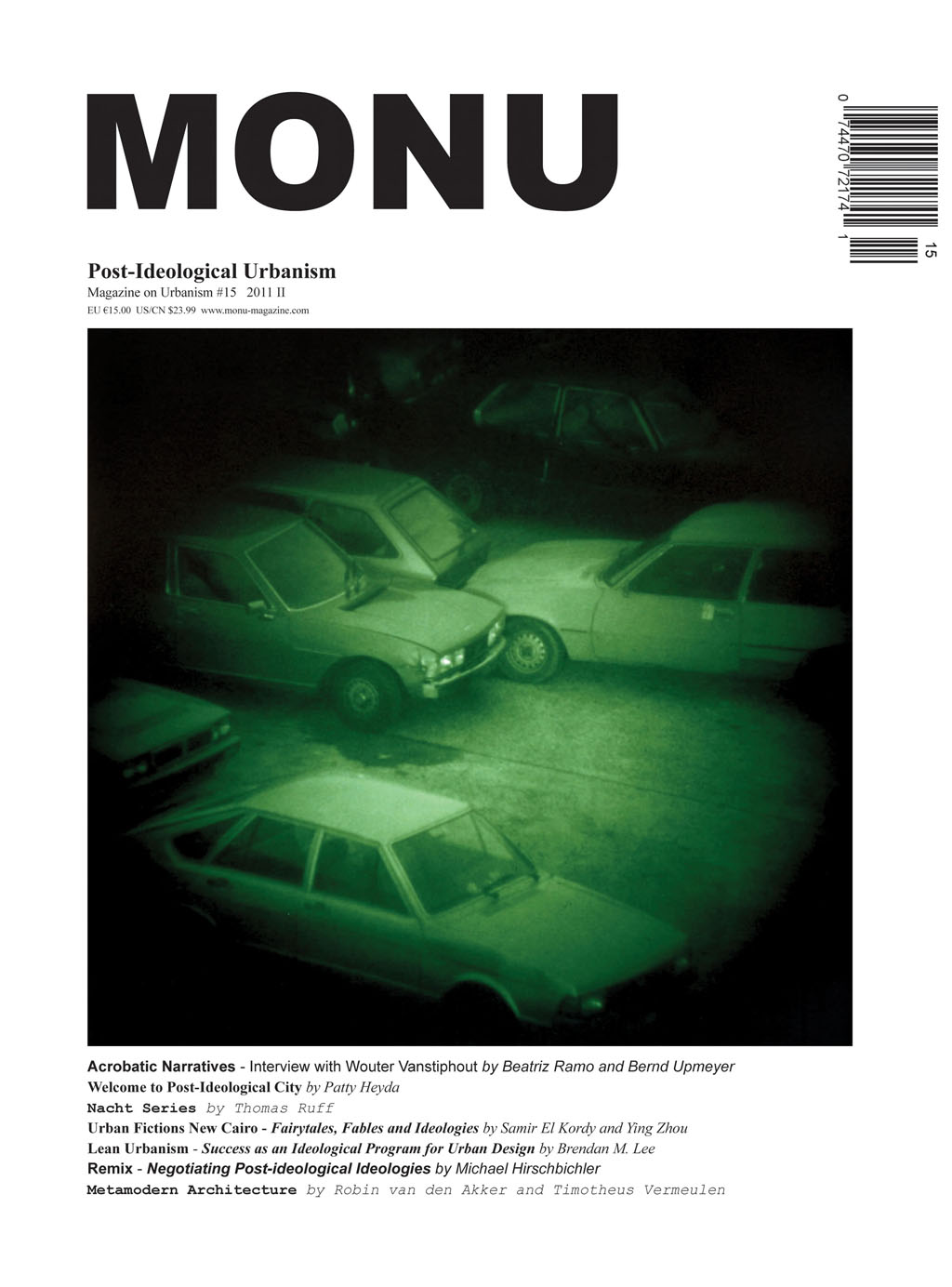21-11-11 // MONU #15 – POST-IDEOLOGICAL URBANISM

(browse the entire issue #15 on Youtube)
Acrobatic Narratives – Interview with Wouter Vanstiphout by Beatriz Ramo and Bernd Upmeyer; Welcome to Post-Ideological City by Patty Heyda; Nacht Series by Thomas Ruff; Urban Fictions New Cairo – Fairytales, Fables and Ideologies by Samir El Kordy and Ying Zhou; Lean Urbanism by Brendan M. Lee; Towards a Political Urbanism by Adrià Carbonell; The Khmer Rouge and the Control of Urban Space by Fredrik Torisson; Spaces Of Negotiation by DoUC (Brendan Cormier, Christopher Pandolfi, and Simon Rabyniuk); Post(card) Ideological by Nathalie Frankowski and Cruz Garcia (WAI Architecture Think Tank); Remix – Negotiating Post-ideological Ideologies by Michael Hirschbichler; Metamodern Architecture by Robin van den Akker and Timotheus Vermeulen; Slipstreaming by Gale Fulton and Stewart Hicks; Greetings from Post-Everything by Mika Savela; O’Mighty Green by Beatriz Ramo – STAR strategies + architecture; Other Dimensions by Wes Wilson; Infra-/ Eco-/ Logi-/ -Urbanism by Geoffrey Thün, Kathy Velikov, and Colin Ripley (RVTR); Choose Your Own Urbanism Presents: The Case of the Missing Ideal By Melissa Dittmer, Jamie Witherspoon, and Noah Resnick
This new MONU issue on the topic of Post-Ideological Urbanism probably touches on one of the most fascinating and biggest issues of our time and in our culture, or what is left of it: the non-ideological – or better post-ideological – conditions of our society when it comes to cities. Today, ideology appears to have become, and to have been reduced to, something merely aesthetic, something you can buy yourself into as Wouter Vanstiphout explains in an interview with us entitled “Acrobatic Narratives”. In that sense cities have become suspicious territories where hypocrisy and fakery prevail when it comes to urban ideologies and one wishes to have some kind of optical device that detects all the lies, similar to a kind of night vision infrared technology that Thomas Ruff used in his “Nacht Series” applying the same technology that was used during the Gulf War. But the usage of alibi ideologies does not seem to be just a contemporary phenomenon and the inference that, for example, the heroic Modernist architects and urban designers were able to work without succumbing to the moral ambiguities of dealing with external political or economic contingencies is probably a fallacy as Brendan M. Lee states in his contribution “Lean Urbanism”. He furthermore explains that we, architects and urban designers, are sometimes envious of our Modernist forebears for their supposed ability to remain true believers in the revolutionary ideologies they proselytized, but that perhaps we have lost the self-confidence in our own ability to bluff. Fredrik Torisson even questions the necessity to follow one coherent system of ideas or an ethical set of ideals in his piece “The Khmer Rouge and the Control of Urban Space” and disqualifies urban ideology as a homogenizer that elevates one preferred ideal over the many. But according to Michael Hirschbichler and his analytical manifesto “Remix – Negotiating Post-ideological Ideologies” there cannot in fact be a post-ideological condition as there is no society imaginable that could exist beyond an ideological framework and is totally free from ideological contexts. What appears to be post-ideological today is in fact the coexistence, silent combat and mutual neglect of innumerable ideologies, neo-ideologies and pseudo-ideologies. In this pluralistic environment, no single ideology or group of ideologies is perceived to be relevant enough to become a point of reference or a single desirable truth. Robin van den Akker and Timotheus Vermeulen describe this prevailing pluralism, or coexistence, in their article “Metamodern Architecture” as metamodern, a condition in which the contemporary structure of feeling evokes a continuous oscillation between seemingly modern strategies and ostensibly postmodern tactics as well as a series of practices ultimately beyond these worn out categories. Following the authors, that kind of metamodernism can be observed in the art works of for example Djurberg, the quirky cinema of Gondry the novels of Murakami or the music of Coco Rosie and movements as diverse as reconstructivism, the new romanticism and the new sincerity. And a new sincerity is obviously needed in a world consisting of a multiplicity of choices and urban outcomes without a single consistent urban ideology as Melissa Dittmer, Jamie Witherspoon, and Noah Resnick point out in their piece “Choose Your Own Urbanism Presents: The Case of the Missing Ideal”.
(Bernd Upmeyer, Editor-in-Chief, November 2011)
Find out more about this issue on MONU’s website.